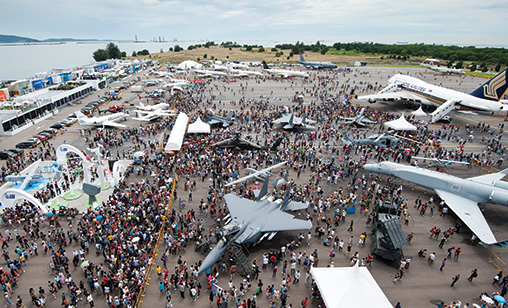News Backgrounder
Singapore aerospace skills outpace rivals across the region
Southeast Asia’s aviation market is one of the fastest growing in the world and will soon become the largest in the world. Singapore has cemented its position as the “Aerospace City of the Future”, but it has rivals elsewhere in the region who want to get in on the act. Associate editor and chief correspondent, Tom Ballantyne, reports.
February 1st 2020
Despite turbulence in global and regional economic markets, Singapore’s aerospace business continues to boom, with its Maintenance, Repair and Overhaul (MRO) sector alone growing at a healthy 8.6% annually. Read More » It accounts for more than 25% of Asia’s MRO revenues and up to 10% of global output.
With the staging of the Singapore Airshow this month, that position is expected to strengthen. On hand will be more than 54,000 trade attendees from 147 countries and regions, a 12.3% increase over the last show in 2018. More than 1,000 exhibitors from 91 countries have invested in being present at the show along with 287 delegations from 91 countries and regions.
 |
Fuelled by rapid economic growth and the popularity of low-cost carriers, almost 40% of new aircraft (42,000 planes) will have been delivered to Asia-Pacific airlines from 2018 to 2037.
B2G Consulting managing partner and co-founder, Frederic Gomer, said in the lead up to Singapore “the consequent need for maintenance as well as the technological upgrades of the region’s existing fleet will boost the role of MRO services in assuring aircraft safety and airworthiness”.
Singapore is not only about MRO. The world’s leading aerospace companies have set up shop in the city. Rolls-Royce carries out engine assembly and testing, training and R&D at its Seletar complex as well as manufacturing titanium wide-chord fan blades.
Pratt & Whitney is investing US$42 million to manufacture hybrid metallic fan blades for the Geared Turbofan (GTF) family of engines. GE Aviation has invested a similar amount in a new facility at Seletar Aerospace Park, the 790 acre aviation zone that is home to a dedicated cluster of aerospace activities and manufacturing.
The GE plant manufactures high pressure compressor vanes for the GE9X engine, which will power Boeing’s new 777X aircraft.
Airbus has a long-term and significant footprint in Singapore. Its Asia Training Centre in Singapore is its regional headquarters for pilot simulator training and the largest facility of its kind in the world.
Local heavyweight SIAEC and ST Engineering, the world’s largest MRO provider, are continuing to add to their offerings in their home city. ST Engineering has moved into the passenger-to-freighter conversion business, developing systems for several aircraft platforms, with an agreement with Airbus to convert its A320s and A330 carriers and another agreement with Boeing for the B757s and B767s.
ST Engineering also owns Aeria Luxury Interiors and DRB Aviation, which specialize in luxury interiors and engineering and certification projects for these interiors. With more than 130 aerospace companies operating in Singapore, its aerospace ecosystem caters for engine and avionics developments, component manufacturing and supply and comprehensive aircraft nose-to-tail services.
The rich prospective pickings in the Singapore aerospace sector are prompting competition from neighbours in Indonesia, the Philippines and Thailand. Thai Airways International, for example, has teamed up with Airbus to set up an “MRO of the Future” complex at U-Tapao, south of Bangkok.
In Indonesia, Garuda Indonesia’s MRO subsidiary, GMF AeroAsia, has joined forces with Lion Air’s Batam Aero Technic to attract multi-national aerospace investment away from Singapore to its shores, particularly for MROs.
Nevertheless, analysts believe Singapore will be more than able to handle the threat of emerging competition in the region. “The overall MRO cost in Singapore is very competitive due to factors such as efficient customs and excellent connectivity and infrastructure,” said Gomer.
“The high concentration of aerospace industry players means the domestic market is extensively layered with key support sectors to absorb subcontracting works. Moreover, the Singaporean MRO industry is based on a solid foundation of forward-looking policy support, cutting edge research and innovation, and a home-grown talent pool. They are competencies clearly lacking in other countries.”
Ever vigilant to competition, last August Singapore reached an agreement with China that covers mutual recognition and oversight of MRO providers in both countries. It is the first such bilateral contract struck by the Civil Aviation Administration of China (CAAC). The Civil Aviation Authority of Singapore (CAAS) has similar agreements with the U.S., Canada, Australia and Hong Kong.
Under the Technical Arrangement on Aviation Maintenance (TA-AM), MRO providers in Singapore and China need only to be audited by their local authority in order to perform maintenance on an aircraft registered in the other country.
Any easing of access to China’s huge airline MRO market would be welcomed by Singaporean MRO companies. One of the biggest is SIA Engineering, which also is committed to partnership projects as it seeks to sustain its market share.
In July, it announced a line maintenance partnership with Thai carrier, NokScoot, for a repair station at Bangkok’s Don Mueang Airport. It is servicing NokScoot’s fleet. The nascent business relationship may lead to the Singapore company setting up a Chinese joint venture.
Whatever happens, there seems little doubt Singapore will remain the region’s primary and dominant centre for all types of aerospace business.